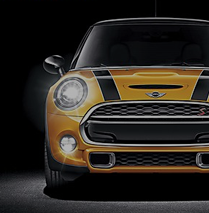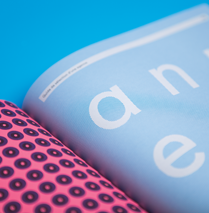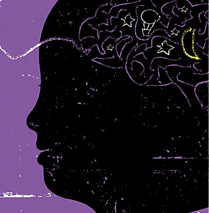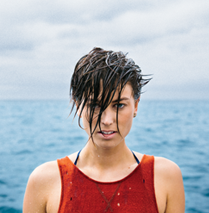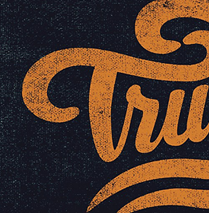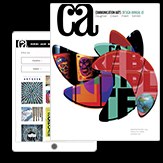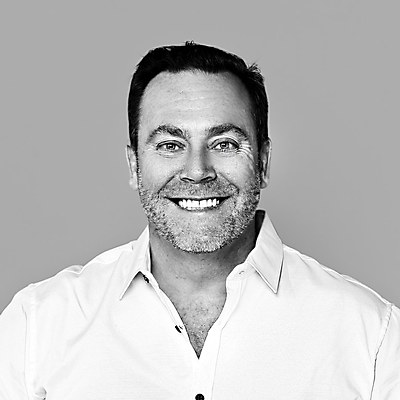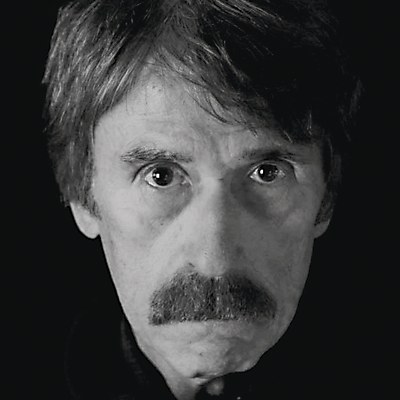How did you discover your passion for advertising and develop the skills necessary to enter the industry? Growing up, I was obsessed with TV, music and pop culture. Advertising lived in the same world—it just came in smaller, bite-sized forms. And while the possibility of working in Hollywood seemed like a pipe dream to a kid in rural Minnesota, breaking into advertising felt much more attainable.
By the time I went to college, advertising was still an option. But so was law (how could it not be after L.A. Law?); having my own talk show (thank you, Oprah); and that nebulous thing called “business.” I naturally gravitated toward a communications studies degree and decided to major in the economic analysis corner of the business universe. I didn’t realize it at the time, but this was a perfect combination of the art and science of our jobs: the study of human behavior and interaction, mixed with market dynamics and supply and demand.
One day during my senior year, I was watching TV and saw an ad with a man walking through a field of grass. You could only see his head and shoulders until he came to a clearing, where it was then revealed he was naked from the waist down with only a Miller Lite bottle cap covering his manhood. I thought, ‘What the hell was that?!’ I was instantly hooked. And I was thrilled when I discovered that the people who made that piece of utter ridiculousness were at an ad agency called Fallon only one hour away in Minneapolis.
So, I busted my ass and was one of the lucky few to get an internship there. Because I was so young when I started, it was less about skills I’d developed to get into the industry and more about what I did to learn on the fly. I raised my hand for everything and said yes to anything, which paid off quickly. I worked on BMW and Holiday Inn, and I got to be in rooms where the likes of Pat Fallon and Bill Westbrook would argue about pitch strategy. I soaked up everything I could and completely fell in love with this business, the agency and the people in it.
What do you do in your current role as president and chief strategy officer of Fallon? Technically, I partner with the leadership team to manage the agency, and I lead the strategy department, which means I have the good fortune of working with a collection of best-in-class strategists who constantly wow me with their smarts and tenacity.
But spiritually, I’ve always felt like my job was two things: One, to set a vision for the agency—because in the words of Yogi Berra: “If you don’t know where you’re going, you’ll end up somewhere else.” And two, to help everyone be their best selves, in work and in life. Because if we aren’t doing that, what are we doing?
I also believe that if you take care of people, the business will take care of itself—especially ours. Our jobs are fundamentally about creating human connections, and you can’t connect with a wide range of people unless your people have a wide range of lived experiences, identities and perspectives. This is why we’ve intentionally assembled a merry band of mismatched weirdos from all walks of life. Every day, we ask them to bring their whole selves to work—all their brilliance and determination, their struggles and vulnerabilities, and who they are and who they want to be. It’s all part of the human experience, and it’s what makes us great at what we do.
You left Fallon for a time to focus on building startups and launch your own strategic consultancy before returning. What was this experience like for you, and what got you to return? Part of what I love about advertising is that we get to make stuff—actual, watchable, listenable and sometimes even touchable things. I like that I can be sitting on my couch on a Saturday watching a cheesy rom-com and an ad we’ve made will pop up. Even after all these years, it still gives me chills.
For me, the dopamine rush of creating things comes from building businesses, too. And that’s what I enjoyed most when I took my sabbatical from adland. In addition to my own consultancy, a few partners and I created a small insights boutique, and I cofounded an electronic locker company and helped launch a startup car maintenance app—among other ventures.
All of it fed my brain in new and interesting ways, but because I was dipping in and out of things, I never found a permanent home like I’d had at Fallon. And I spent so much time serial-entrepreneuring that I grew farther and farther from the creative process. So, when chief executive officer Rocky Novak called me and said, “Come back to Fallon and help write the next chapter of the agency,” it was hard to say no. It was a place I loved with people I still felt connected to. And although nearly a decade had gone by, Fallon was still the audaciously ambitious place that believed in the power of creativity. I wanted to be part of that again. To take on a leadership role was an enormous responsibility as well as a tremendous honor.
What have been some of your favorite campaigns to work on at Fallon? The advertising gods smiled on me early in my career, and the very first Fallon pitch I was ever assigned to was on a team with Bob Barrie—the guy who’s won more than 40 One Show pencils, has work in the permanent collection at the Museum of Modern Art and was named to Adweek’s All-Star Creative Team five times. He and his partner had created a print campaign featuring images from Sports Illustrated. On each image, they’d identify one small area that could tell a larger story. Then they’d tear out that portion of the image and, in its place, insert a quote that poignantly captured the moment.
It was an elegant way to highlight Sports Illustrated’s photography and writing. But to me, the most amazing part was that Bob insisted the “torn out” pieces look as real as possible. So, he meticulously shredded countless itty, bitty strips of paper to create a perfect tear for each ad.
I stood outside his office watching, perplexed. I didn’t know much about advertising at the time, but I knew enough to know that one of the most talented professionals in the industry was relegating himself to the duties of a kindergartener. But what he was doing mattered. And for the first time, I began to appreciate the meaning and power of craft. It was beautiful and brave. Tedious and time-consuming. And it sat in the very wide divide between good and great.
Over the years, I’ve been lucky to work with—or just orbit near—incredible artists: Director and filmmaker Alfonso Cuarón shot several PBS spots with us long before making Gravity and Roma. As did director Scott Hicks, who directed Geoffrey Rush’s Oscar-winning performance in the film Shine. Robert Redford did the silky-smooth voiceover for our United Airlines campaign, and Academy Award–winning animator Aleksandr Petrov painstakingly painted each frame for one of our spots by hand. In each case, someone went the extra mile to make something truly extraordinary. And it’s one of the things that makes our business special.
My other example is bookended in an interesting way. In 2003, we helped United launch its low-cost carrier Ted. To get an airline off the ground—sorry, the puns are just way too easy—it’s critical to drive advanced bookings. But that was a huge challenge because Ted’s home market was Denver, and the locals weren’t fans of United at the time.
Since Ted was conveniently named after a human being, we decided to introduce it like a real person, showing off Ted’s personality, what was important to “him” and what it was like to have “him” around. Unlike United’s serious business travelers, Ted would cater to vacationing leisure travelers, which meant the brand’s personality was more optimistic, fun and spontaneous. So, we decided to initiate a random acts of kindness strategy, buying unsuspecting Denverites coffee, sending flowers to hospitals, hosting parades and other acts.
It was the perfect way to introduce Ted the brand first and then talk about Ted the airline later, and it was an activation before an activation was even a thing. Most importantly, it showed me the power of a brand doing something rather than just saying something. And now, more than 20 years later, our Arby’s crew has taken that same idea and pushed it to the next level. From creating french fry–flavored vodkas and diss tracks with Pusha T to breaking TikTok with a missing menu board, Arby’s activations consistently generate billions of impressions every year and have planted the brand firmly in the middle of culture.
Tell us about some of the diversity, equity and inclusivity (DEI) initiatives you’ve led since returning to Fallon. What did they address within the agency? I returned to Fallon in the summer of 2019, and George Floyd was murdered ten months later less than ten miles from our home office. Prior to that, it wasn’t as if DEI hadn’t been a focus. We had DEI goals. We had a DEI employee group. But we realized none of it was enough. It wasn’t central to the agency or part of our DNA in the way it needed to be.
For me, it was also a personal moment of reflection. I was a Korean adoptee who’d grown up in a family with French-Canadian, English, Swedish, Norwegian and German roots. So, I knew more about lutefisk and lefse than kimchi and bulgogi. And while I presented as Asian, I was privileged and accepted into white culture in a way many weren’t. I wrestled with a lot of questions. Who was I? Had I done enough to lift up other people of color? How had my experience growing up in advertising been different from what I wanted the next generation’s to be?
I had plenty of conversations with plenty of people. A good friend of mine who’s Black put an incredibly sharp point on it. He said, “When we were coming up in the professional world, we put our heads down and asked people to see our work, not our color. But this generation is demanding that people see both.”
We at Fallon asked ourselves hard questions and had raw conversations. And in the last few years, we’ve completely reimagined our DEI employee resource group, establishing five pillars that focus on everything from building pipelines externally to fostering belonging internally. We’ve adopted policies that impact our talent, casting, suppliers and vendors. We’ve interrogated how we work and created a manual of best practices for every department to apply DEI in everything they do. We’ve set goals, reviewed our progress and then started all over again.
What trends in advertising are you most interested in, and why? Everyone’s talking about AI, so I’m not going to—even though it’s here, real and going to have far-reaching implications. Instead, I’ll talk about something more conceptual that’s impacting our business as well as offering an opportunity: Taylor Swift. Obviously.
Inside our hallways, there has been a lot of Taylor chatter lately. Not about her legion of Swifties, her status as a female role model or how she single-handedly boosted the economies of cities on her Eras tour. It’s been all about Taylor and Travis—more specifically, why we care about them so damn much. Sure, they’re cute together, seem like decent human beings and would probably make adorable, music-making, touchdown-catching babies. But it doesn’t explain the over-the-top investment we all seem to have in their relationship. There must be another reason.
Here’s a guess: monoculture is dying and we’re kind of bummed about it. Which might be less of a trend and more of a reality. There aren’t many things we get to experience together anymore. We used to gather around the TV on Thursday nights and talk about what happened on Friday mornings, but the water cooler’s not as fun in the streaming world where nobody’s watching the same thing at the same time. With the advent of one-to-one marketing, we don’t see the same messages. And everything’s so hyperpersonalized and customized, there is becoming less and less commonality.
So, when something comes along that we can all root for and experience together, we eat it up. We’re hungry for it. And maybe there’s some opportunity there. As advertisers, how can we create things that unite us? Things that will capture our collective imaginations and make us stop and cheer, jeer or just feel something that reminds us, sometimes, we actually are all in it together?
If you could choose any brand to create and ad for, what would it be and why? It’s always fun to think about how you’d resurrect a beloved brand from the ashes, whether it was literally shuttered or just fell off the map. Pan Am. TaB. Kodak. When I was consulting, I did some work on the Hostess Twinkies relaunch when it returned to shelves after bankruptcy. Yellow sponge cake is a pretty killer creative canvas.
There are also categories we love working in and have gained a ton of experience. Airlines. Alcohol. Automotive. Apparently, anything that starts with the letter A. But the real answer is that it’s more about the brand manager than the brand. I want to work with ambitious clients who want to set the world on fire. Ones that are willing to take risks and stay restless, no matter how much they’ve already achieved. If you’re willing to call a water Liquid Death or film a dude falling 23 miles through the Earth’s stratosphere, I want to work with you.
What is one challenge currently facing advertising agencies that they need to address to remain relevant? Gen Alpha is coming, and we’d better be ready for it. I don’t remember when we were so concerned about a generation still in utero. But the oldest Gen Alphas became teenagers last year, and they will be the most digitally adept humans we’ve ever seen. They literally don’t know a world without Instagram and iPad—both ironically launched in 2010, the year that began Gen Alpha—and they already have more influence than we’d ever imagine a bunch of backpack-toting elementary schools could.
They will be more diverse than any generation before them, and they’ll expect that what they see in the media, entertainment and advertising reflects that. They’re already more comfortable with and concerned about topics like mental health and purpose than most of us were decades later in life. And they’ve even invented their own language: I asked my twelve-year-old niece if she knew what rizz meant, and she acted like it was the most insulting thing anyone ever said to her.
It’s not to say that we can now ignore Gen Zers and all who came before them. But I believe this is going to be a much different group of humans whose tech-savviness, access to information, and ability to amplify their voices and express themselves on a variety of platforms means they’re going to have much higher expectations for the brands they interact with. And, as marketers, we need to find ways to meet them where they are.
I guess the only saving grace is that they’re into things like Skibidi Toilet, so we might have a little time before they outpace us.
What advice would you give strategists just entering the profession? Two things: be curious and be a student of the craft.
Be Curious
It’s incredibly difficult to have a truly original thought. So, I ascribe to the theory that creativity is about combining known things together in unexpected ways. Speaking of, I just read that 50 Cent and Bette Midler are buds. Please tell me there’s a collab coming.
I believe the same thing holds true for strategies, which means strategists need to have a vast, deep reservoir of material to pull from. And I don’t just mean stats, facts and data—although those are helpful too. I mean things that light up your brain, challenge you to think about things differently and give you a window into what’s happening in the world.
It’s learning how things work, whether it’s a high-level theory or a thing in your house you’ve been meaning to fix. It’s listening to interesting people talk about how they approached a problem or what it means to be human, which is why I’m obsessed with MasterClass. It’s flooding your senses with music, art and food. Paying attention to what people are talking about and what they aren’t. It’s pop culture to politics and everything in between. And the best part is you can justify about anything as work!
Be a Student of the Craft
Strategy is a strange discipline, especially creative strategy. There are two ways to get better at it: doing it and watching other people do it. I perhaps could’ve phrased that differently, but I’m going with it.
The doing it way is about flexing your own muscles, jumping in and trying to get as many at-bats as you possibly can. And if you don’t have any immediate plate appearances, give yourself your own assignment. Practice on a brand you love. Try to figure out the strategic scaffolding behind a great creative idea. Mentally walk through the steps you’d take to figure something out.
The watching other people do it way comprises one part consuming theory, like reading seminal books such as Positioning by Al Ries and Jack Trout, How Brands Grow by Byron Sharp, and Juicing the Orange by Fred Senn and Pat Fallon—I know I’m biased with that last pick, but it’s legitimately a good read; one part getting exposed to great cases and great work through channels like the Effies, Chiats, podcasts and Cannes Lions; and one part listening to other strategists, hearing how they threaded needles, cringing through their horror stories and reveling in their victories.
It’s all part of being a strategist. And if you learn to love it, it might just love you back. ca


